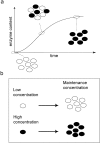Modeling network dynamics: the lac operon, a case study
- PMID: 12743100
- PMCID: PMC2172934
- DOI: 10.1083/jcb.200301125
Modeling network dynamics: the lac operon, a case study
Abstract
We use the lac operon in Escherichia coli as a prototype system to illustrate the current state, applicability, and limitations of modeling the dynamics of cellular networks. We integrate three different levels of description (molecular, cellular, and that of cell population) into a single model, which seems to capture many experimental aspects of the system.
Figures



References
-
- Carrier, T.A., and J.D. Keasling. 1999. Investigating autocatalytic gene expression systems through mechanistic modeling. J. Theor. Biol. 201:25–36. - PubMed
-
- Chung, J.D., and G. Stephanopoulos. 1996. On physiological multiplicity and population heterogeneity of biological systems. Chem. Eng. Science. 51:1509–1521.
-
- Delbrück, M. 1940. Statistical fluctuations in autocatalytic reactions. Journal of Chemical Physics. 8:120–124.

